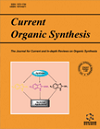- Home
- A-Z Publications
- Current Organic Synthesis
- Previous Issues
- Volume 21, Issue 8, 2024
Current Organic Synthesis - Volume 21, Issue 8, 2024
Volume 21, Issue 8, 2024
-
-
A Recent Update on the Visible Light-promoted Organic Transformations - A Mini-review
More LessVisible light-induced reactions are a rapidly developing and powerful technique to promote organic transformations. They provide green and sustainable chemistry and have recently received increasing attention from chemists due to their wide application in organic synthesis. Light energy is eco-friendly, cheap, green, and inexhaustible with potential industrial and pharmaceutical applications. In this review, the most Read More
-
-
-
Hybrids of Benzimidazole-oxadiazole: A New Avenue for Synthesis, Pharmacological Activity and Recent Patents for the Development of More Effective Ligands
More LessBackground: Two significant families of compounds i.e. 1,3,4-oxadiazole and benzimidazole, have undergone extensive investigation into their pharmacological characteristics and possible therapeutic applications. Both classes have shown their potential in a variety of applications, and because of their synergistic interactions, they may have an even better therapeutic impact when combined. Objectives: To produce a sp Read More
-
-
-
Anti-inflammatory and Antimicrobial Potential of 1, 3, 4-oxadiazoles and its Derivatives: A Review
More LessAuthors: Tarun Chaudhary, Prabhat Kumar Upadhyay and Ritu Kataria1, 3, 4-oxadiazole and its derivatives have significant anti-inflammatory and antimicrobial property. Their precise mechanism of action is not known but it is postulated that they act by inhibiting the biosynthesis of certain prostaglandins. 1, 3, 4-oxadiazoles are a class of heterocyclic compounds with wide variety of biological and pharmacological activities. They have been reported to possess analgesic, antimicrobial, antipyretic a Read More
-
-
-
Reactions and Biological Activities of Hydrazonoyl Halides
More LessThis review covers the literature information on the chemistry of hydrazonoyl halides with different substrates to give heterocyclic compounds. From the foregoing survey, it seems this provides a useful and convenient strategy for the synthesis of numerous heterocyclic derivatives. The subject of such reactions is still ongoing and undoubtedly will provide new fused functionalized compounds of both industrial and biologic Read More
-
-
-
Recent Advancements in the Synthesis of α-fluoroalkylated Azine-derived Heterocycles through Direct Fluorination
More LessAuthors: Oksana M. Shavrina, Yuliya V. Rassukana and Petro P. OnyskoThe review highlights recent advancements in the synthesis of α-fluoro and α,α- difluoroalkylated azines, focusing on two main approaches. The first approach involves nucleophilic deoxofluorination, wherein α-hydroxy- or α-oxoalkylated azines are treated with diethylaminosulfur trifluoride or other S-F reagents to introduce fluorine atoms. The second approach employs direct electrophilic benzylic fluorination, whereby alkylazi Read More
-
-
-
Tetra-azolium Salts Induce Significant Cytotoxicity in Human Colon Cancer Cells In vitro
More LessAuthors: Muhammad Ashraf, Amna Kamal, Ejaz Ahmed, Haq N. Bhatti, Muhammad Arshad and Muhammad Adnan IqbalBackground: Azolium salts are the organic salts used as stable precursors for generating N-Heterocyclic Carbenes and their metal complexes. Azolium salts have also been reported to have significant biological potential. Hence, in the current study, four tetra-dentate azolium salts were derived from bis-azolium salts by a new synthetic strategy. Methods: The tetra azolium salts have been synthesized by reacting the imid Read More
-
-
-
Synthesis, DPPH Radical Scavenging, Cytotoxic Activity, and Apoptosis Induction Efficacy of Novel Thiazoles and Bis-thiazoles
More LessAuthors: Amr Negm, Yasair S. Al-Faiyz, Sayed M. Riyadh and Abdelwahed R. SayedBackground: Heterocyclic materials-containing thiazoles exhibited incredible importance in pharmaceutical chemistry and drug design due to their extensive biological properties. Methods: Synthesis of thiazoles and bis-thiazoles from the reaction of 2-((6-Nitrobenzo[ d][1,3]dioxol-5-yl)methylene)hydrazine-1-carbothioamide with hydrazonoyl chlorides in dioxane and in the existence of triethylamine as basic catalyst. Read More
-
-
-
One Pot Synthesis of New Benzimidazole Derivatives with Exceptionally High Luminescence Quantum Efficiency
More LessAuthors: Abraham Mensah, Xin-Ye Liu, Bing-Xiang Hu, Ennin V. Kweku, Fang-Ming Wang, Li-Zhuang Chen and Shao-Jun ZhengAim and Objectives: There are different approaches to the synthesis of benzimidazole. In this article, five new benzimidazole derivatives, BMPO, Me-BMPO, Di-MeBMPO, F-BMPO and Cl-BMPO where (BMPO=3-[(1H)-benzo[d]imidazol-2-yl]pyridin-2(1H)-one), have been prepared. Another study was carried out on luminescence properties and their potential applications for the detection of transition metal ions. Materials and Methods: Read More
-
-
-
Synthesis and Antitumor Activity of Some NewN1-(8-fluoro-4-oxoquinolin-5-yl)amidrazones
More LessBackground: Hydrazonoyl chloride, accessible from the respective 5-amino-8-fluoro- 4-oxoquinoline-3-carboxylate, undergoes a reaction with sec-cyclic amines to generate N1-(1- ethyl-8-fluoro-4-oxoquinolin-5-yl)amidrazone carboxylates. Introduction: A novel set of N1-(1-ethyl-8-fluoro-4-oxoquinolin-5-yl)amidrazone carboxylates (7a-h) incorporating N-piperazines or related congeners was synthesized via interaction of the Read More
-
-
-
Corrigendum to: Recent Progress on Synthesis of Functionalized 1,5- disubstituted Triazoles
More LessAuthors: Manoj K. Jaiswal, Abhishek Gupta, Faisal J. Ansari, Vinay K. Pandey and Vinod K. TiwariTwo errors appeared in the text of the manuscript titled “Recent Progress on Synthesis of Functionalized 1,5- disubstituted Triazoles”, 2024; 21(4) : 513-558 [1]. We regret the errors and apologize to readers. The original article can be found online at: https://www.eurekaselect.com/article/131107
-
Volumes & issues
-
Volume 22 (2025)
-
Volume 21 (2024)
-
Volume 20 (2023)
-
Volume 19 (2022)
-
Volume 18 (2021)
-
Volume 17 (2020)
-
Volume 16 (2019)
-
Volume 15 (2018)
-
Volume 14 (2017)
-
Volume 13 (2016)
-
Volume 12 (2015)
-
Volume 11 (2014)
-
Volume 10 (2013)
-
Volume 9 (2012)
-
Volume 8 (2011)
-
Volume 7 (2010)
-
Volume 6 (2009)
-
Volume 5 (2008)
-
Volume 4 (2007)
-
Volume 3 (2006)
-
Volume 2 (2005)
-
Volume 1 (2004)
Most Read This Month
Article
content/journals/cos
Journal
10
5
false
en


